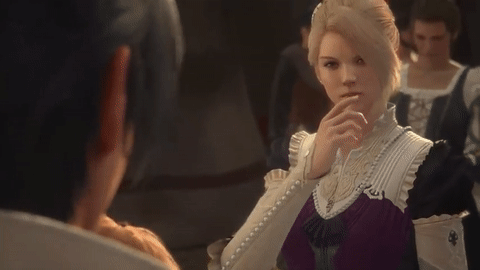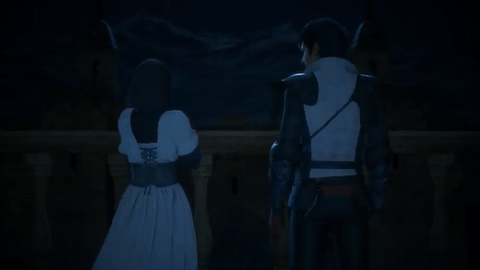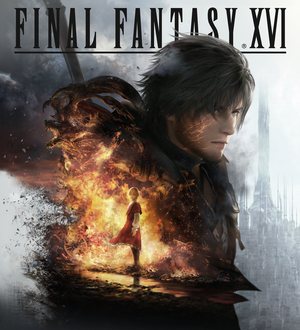Final Fantasy XVI - Prologue Breakdown
|
Final Fantasy XVI is a 2023 action role-playing game developed and published by Square Enix. I greatly anticipated this new installement as a fan of the series since 1997. I've played for a dozen of hours so far, and the game is up to my expectations. The prologue especially stands out from as a great example of narrative structure that teases the rest of the adventure in an elliptic and emotionally-intense way. I consequently felt the need to break the prologue down, and to share my findings here. To me, its strengthes mostly are:
|
|
Approach
My approached consisted in:
- Finding a good Youtube video as I didn't record my own playthrough
- Transcribing my personal excitation as I remember playing it for the first time
For that, I use a slider on the right of the screen that shifts through different moods





- Annotating the cutscenes, special events, and gameplay phases

- Annotating all the narrative elements

New question that the player may wonder about 
Answer to a question previously wondered about 
Wrong assumption, or correction of an answer previously provided 
Unrelated piece of information that the game gratuitously provides
Let's first have a look at the whole video!
Here the transcription that I split into 2 charts:
- The list of all the narrative elements for every aspects of the story that I perceived

- The excitation I felt while playing the game

Well-though structure
What a worst way to start an epic adventure than delivering packages, or collecting vegetables from a garden? The first hour of a game is critical to engage players on the long run: they need to foresee the stakes, to imagine how powerful their characters would become, and to desire reaching such level as soon as possible.
This is exactly what Final Fantasy XVI does. The prologue starts a colossal duel between giant creatures (Eikons). Developers briefly invites the player to take part in this scene thanks to a scripted gameplay - providing them with an overview of the destruction their characters may latter cause. The player character then obverses a large-scale battle where the contenders cast spells, ride chocobos, and summon giant creatures as well. Developers introduce badass antagonists, and eventually end this first part with a cliffhanger as the player character gets critically damaged.
Note that the gameplay remain quite simple and linear throughout the prologue: at this stage of the prologue, the player character is only able to move around. Developers wait for almost 20 minutes before introducing the basis of the combat system through a series of short tutorials. This second part of the prologue doesn't include any other action-oriented scenes, and rather focuses on laying the foundations of the game story: the world of Valisthea, the social organization, the personalities of the different characters, and the incoming threat. The pace is slower and provides the player with enough time to assimilate all the information.
The mission in Stillwind lets the player practicing combat and introduces additional mechanics that would have saturate the previous sequence if introduced at the same time. It's also a great opportunity to experiment with the different abilities of the player character - before reaching the final part of the prologue where the stakes are too important for such risks. There is very little advancement in the story during this mission: it's all about gameplay.
Phoenix Gate is the fourth and last part of the prologue. It concludes with explanations that are clear enough to understand of the events that led to the downfall of the player character. Moreover, it lets the player rediscovering the duel between Phoenix and Ifrit from a new point of view. Knowing who the characters are (and hearing their dialogue) adds an emotional charge to the combat - turning this scene into the climax of the prologue. Everything is wrapped up. The heartbreaking sequence of destruction, deaths and betrayals eventually introduce a new plot that keep the player engaged beyond the prologue.

Buildup of the triggering event
The player first embodies a very enigmatic soldier. All we know about him is the name "Wyvern", the tattoo of a paria (latter called Bearers or Branded), and what seems to be the memory of a duel between giant creatures. Few minutes later, we learn he actually was a Lord named Clive Rosfield. The player naturally starts wondering what happened to the character. The developers did a great job at teasing the triggering event and building up the tension all along the prologue.
Clive has a close relationship with his brother Joshua. Their bound goes beyond their duties of a Lord and Shield. We can easily understand it from the scene in Rosalith: Joshua cheers his brother, then heals his wound, and they both share the same excitement when hearing about their father's returnal. However, we discover how close their relationship is after the scene of the feast in the Phoenix Gate arc as they reveal their admiration and trust in each other. Exposing their stength of their bond greatly increases the dramatic tension during the final duel between the Eikons - especially since Clive is unable to defend the brother he loves so much, and begs the Eikon to spare him.
The camera staging and overlay let us guess the Clive actually turns intro Ifrit. However, such information rises an important question: "why would Clive kill his brother?". At this stage of the game, I assume that only minds at peace can control Eikons, and the fact is that Clive probably suffers from an inferiority complex. We all noticed the relationship between Clive and his mother (Lady Anabella), and how the former avoids looking her in the eyes. However, I believe that the developers spread many additional clues all along the prologue:
- During the training scene, Lord Murdoch insisted that no one should ever doubt about Clive's abilities
- Clive seems both eager and afraid to participate in his first mission - and thereby, to prove himself
- Clive refrains from warming Jill on the balcony - as he wasn't worthy enough to touch her
- ...
 |
 |
Although being the first born of Lord Rosfield, Clive gets "rejected" by the Phoenix. The way Lady Anabella speaks of him and this failure definitely plays a critical role in Clive's lack of self-confidence. Her disappointment and her strong disagreements with Lord Rosfield show how precarious their relationship is, and teases the betrayal leading to the downfall of her own family.
All these signs are all-the-more indicative as the first part of the prologue teases that Clive ends up as a branded mercenary.
Elliptic storytelling
In his book "How Star Wars Conquered The Universe", Chris Taylor explains how the movie writers refrained from explaining every single plots to create mysteries that contribute to the atmosphere and allow fans to debate topics such as "who really is Anakin's father?". This is an approach that the developers of Final Fantasy XVI followed - at least, during the prologue itself. Apart from the mysterious atmosphere it creates, I believe such approach also helps:
- Keeping the dialogues natural
- Smoothing the overall experience without interrupting the flow with unnecessary explanations
- Further engaging the player with enigmatic elements they want to resolve or to learn more about
- Providing them with a genuine autonomy to do so - without holding their hands
The game provides the player with a lot of information about the world, the society, the supernatural and the characters - but just enough for the player to extrapolate the missing pieces of information. If necessary, the player can still pause the game and access the Active Time Lore encyclopedia that includes additional references.
By the end of the prologue, the player has learned enough information about the past events to understand the rest of the game. However, there are still plenty of mysteries to unveil:
- The game refers to world locations and nations without providing any maps at this stage of the game
- The player understands there is a war - but know neither the trend nor the alliances
- We don't know the reason(s) why the Empire and Lady Anabella betrayed Rosaria
- The player knows the identity of the main character - but his personality seems more complex than it first looks
- The lore around the crystals and the Eikons remains very vague
- We don't know why Clive actually turned into Ifrit - nor the identity of the hooded character
More many answers will be provided as I'll progress through the game - but there is no doubt that the prologue of Final Fantasy XVI is one of the best introduction I have ever played, and I'm eager to complete the game!
